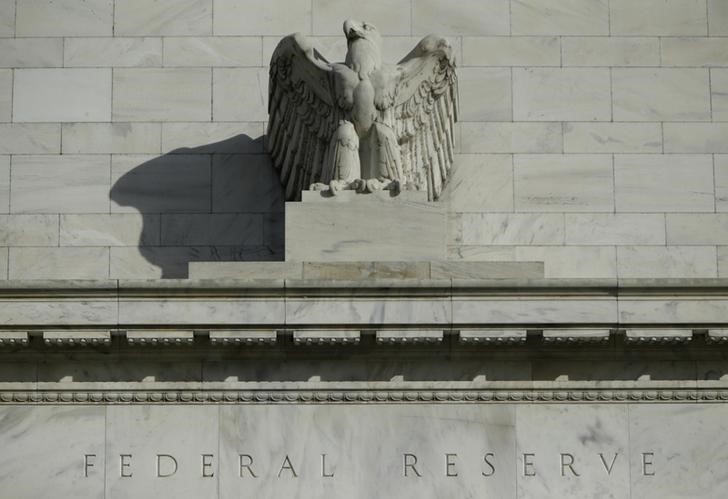(Bloomberg) -- “Recovery trade” has become too flaccid a term for what’s going on in the stock market, courtesy of the Federal Reserve.
The S&P 500 has surged almost 40% since March 23, its fastest advance since 1933. The Nasdaq 100 briefly erased all its losses on Wednesday. Corporate borrowers are issuing debt at a record clip as short bets against high-yield bonds evaporate. And with Treasury yields pinned down by interest rates close to zero, valuation models that plot corporate earnings against bond payouts show stocks -- somehow --remain historically cheap.
It’s nothing new -- it’s just lasting longer than anyone expected. With equities powering past millions of lost jobs, images of protesters facing off with police over racism and daily reminders of the coronavirus’s economic toll, some market-watchers are seeing shades of moral hazard. By injecting massive liquidity through Treasury purchases and backstopping corporate bond markets, they say, the central bank is bailing out businesses that may have struggled and fomenting wealth inequality. At the investor level, it’s cover to pile in to riskier assets with little chance of losses.
“The Fed indicating that they’re going to keep interest rates low for a very long period of time, that they’re going to be supportive of the corporate bond market -- in essence what you’re doing is you start to incentivize risk taking,” said Brian Levitt, global market strategist at Invesco (NYSE:IVZ). “There’s a lot of money on the sidelines collecting zero for a long period of time, investors start to think about how to allocate that money.”
In Chairman Jerome Powell’s own words, policy makers acted “forcefully, proactively and aggressively” to combat the effects of the virus on the U.S. economy. The raft of support measures that followed included nine special lending facilities aimed at money markets, municipalities and the credit markets, among others.
The impact was immediate: the S&P 500 bottomed on March 23, the same day that the Fed announced it would take the unprecedented step of buying corporate debt and exchange-traded funds tracking those securities. A record $27 billion flowed into fixed-income ETFs in May after the Fed kick-started its bond-buying program on May 12.
Lifelines are visible in stock market’s most battered corners. Economic reopening optimism has boosted the small-cap Russell 2000 by nearly 16% over the past month, outpacing the broader S&P 500’s 10% gain. Retail brands such as Gap Inc (NYSE:GPS). and L Brands Inc (NYSE:LB). have both surged by nearly 53% over that time, while easing global lockdown measures have buoyed shares of Royal Caribbean (NYSE:RCL) Cruises Ltd. by 42%.
S&P 500 futures contracts slipped Thursday after the underlying gauge rallied 3.1% in the prior four days.
The Fed’s actions have drawn criticism from high-profile naysayers such as Scott Minerd, chief investment officer at Guggenheim Investments, who said Wednesday that the central bank sent the world a “buy signal” through its programs propping up the corporate bond market. That concern has been echoed by Fed veterans such as William Dudley.
“People who have high-yield debt outstanding, a lot of times that happens by choice,” said Dudley, former New York Fed president, in a Bloomberg Television interview. “For the Federal Reserve to intervene and support those asset prices, is basically creating a little bit of a moral hazard in the sense that you’re encouraging people to take on more debt.”
In addition to the lending facilities, the Fed also slashed rates to near zero and pledged unlimited quantitative easing, ballooning its balance sheet to $7 trillion. That’s confined benchmark 10-year Treasury yields to an 18-basis point range over the past month near historically low levels. By some measures, that makes stocks more attractive: one fashionable indicator, the price-liquidity ratio -- which compares S&P 500 market cap versus total money supply -- suggests that equities actually look cheap, even as earnings collapse.
“The potential is there for another bubble in financial assets. I view the Fed as another data point in the supply demand equation and the old adage of “don’t fight the Fed” comes to mind,” said Dan Russo, chief market strategist at Chaikin Analytics. “Does that have the potential to inflate bubbles? Yes.”
Of course, it’s hard to argue that the Fed had other options when faced with a pandemic of unprecedented proportions and an all-but-guaranteed recession. Even with the raft of emergency measures, the extent of the economic damage has been catastrophic. The U.S. unemployment rate is expected to surge to 19.5% in May, after spiking to 14.7% the prior month. Average hourly earnings are forecast to rise by 8.5% on a yearly basis, suggesting that the hardest hit have been low-income earners.
Powell himself has acknowledged the extreme length the central bank has gone to in order to cushion the economy. He insisted that the Fed’s policies “absolutely” don’t add to inequality and said the central bank’s real aim is to preserve jobs by keeping companies afloat.
“Think about where we were in early April with inflation expectations close to one and falling and 6 million people joining the ranks of the unemployed,” Invesco’s Levitt said. “If the Fed doesn’t respond to that or even tightens in that environment like they did during the Great Depression, you exacerbate the situation and make it far worse.”
Still, the ensuing equity rally born from those policies has bedeviled bears and is even starting to confuse the bulls. For Albert Edwards at Societe Generale (OTC:SCGLY), who is sticking to his bearish call on mega-cap technology stocks, it’s been an exercise in frustration.
“We are now only 10% from February’s all-time high, and with the U.S. unemployment rate heading toward 20%, one might ask: At what point does the stark disconnect between Wall Street and Main Street become a political embarrassment for the Fed?” Edwards wrote in a note last week. “Maybe never.”
©2020 Bloomberg L.P.
